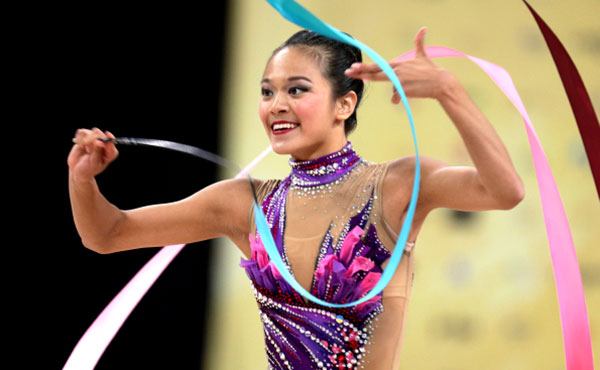
By Blythe Lawrence
On and off the competition floor, Laura Zeng loves a good routine.
There’s the litany of rituals she goes through on competition day, among them a cold shower and eating dark chocolate. Then there’s what she presents when she takes to the rhythmic carpet: a tapestry of intricacy and difficulty with each apparatus, all exercises tailored to have the maximum impact in the changing world of rhythmic gymnastics.
For that world has changed: as of February, the rhythmic gymnastics code of points became open-ended for difficulty. Before, the maximum score a gymnast could receive for difficulty was 10 points. Today, the sky’s the limit. (Execution, the other component of a rhythmic score, remains capped at 10 points.)
Much like in artistic gymnastics, where open-ended difficulty became the norm in 2006, the new rules have dramatically altered the look of rhythmic routines as gymnasts rush to pack in extra difficulty. The downside is that this can lead to mistakes, damaging the execution score. Finding a balance between high difficulty and clean execution is key, and it’s a challenge Zeng has risen to with gusto.
“I’m all for it,” she says of open-ended difficulty. “A changing code is always a positive step forward for the sport. However, I do wish that artistry was emphasized more in this code, because I believe rhythmic is a combination of both.”
In two previous appearances at the World Championships, Zeng has elevated the U.S. rhythmic program to new heights. The 18-year-old owns the best ever U.S. finishes in the all-around at Worlds (sixth in 2017), the best finish in an apparatus final at Worlds (fifth with the ball and ribbon in 2017) and the top American placement at an Olympic Games (11th in Rio in 2016).
Not that she pays too much attention to the scoreboard. “I’m very proud to have been able to break into the top 10 in the world for Team USA,” she said. “But going into Worlds this year, the biggest pressure is about cleanly executing routines, rather than results. For me in particular, the pressure isn’t about placement, but about leaving something special on the carpet.”
With an eye to the change to the Code of Points, Zeng has strategically increased some of her difficulty over the past year. But there’s a distinct you-haven’t-seen-anything-yet quality in her approach to the World Rhythmic Gymnastics Championships, taking place this week in Sofia, Bulgaria.
“It’s also definitely still a work in progress,” she said. “I’m still definitely learning something new every day and trying to be involved more.”
After so much success, one thing she’s come to realize this season is that dramatic tweaking can be a necessary component for continuing to move forward. When her ball routine gave her some problems during the early part of the season, Zeng and coach Natasha Kilmouk decided to start over from scratch. The result was that Zeng debuted a brand new routine with the apparatus at July’s USA Gymnastics Championships.
With two years to go before the Tokyo Olympics, she’s focused on the long game. “All of our work this season will continue to develop for the next two years,” she says. It’s all part of the routine, of course.




